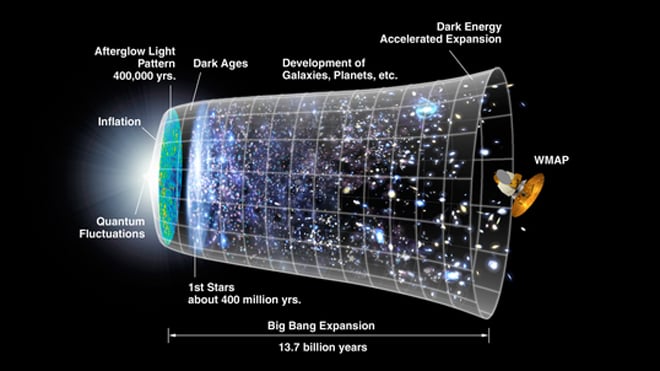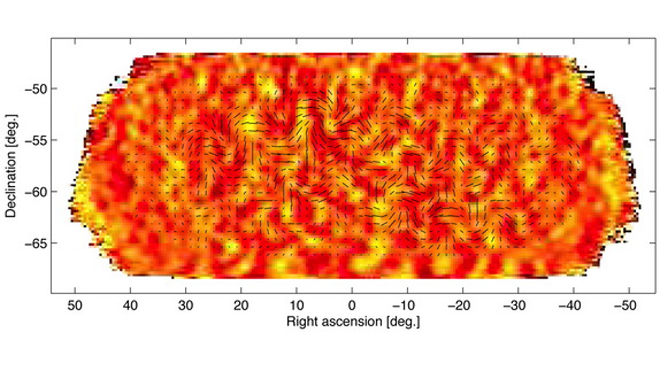

This NASA graphic shows the universe as it evolved from the big bang to now. Goddard scientists believe that the universe expanded from subatomic scales to the astronomical in a fraction of a second after its birth. (NASA/WMAP)
Scientists have discovered new Big Bang evidence they say is the first that directly supports the expansion of the universe in the instant following the birth of the universe around 13.8 billion years ago.
Astronomers believe that the universe exploded from a tiny singularity and expanded itself out in all directions in the literal fraction of a second that followed, beginning just 10 to the minus 35 seconds (roughly one trillionth of a trillionth of a trillionth of a second) after the universe’s birth. Gravity would inevitably coalesce Matter over hundreds of millions of years later into planets, stars, and ultimately our own solar system some 4.6 billion years ago.
Likening the astonishing event to ripples from a ball kicked into a pond, the Big Bang would fuel expansion-caused ripples in the ancient light, which remains imprinted in the skies in a leftover glow called the cosmic microwave background.

The tiny temperature fluctuations of the cosmic microwave background (shown here as color) trace primordial density fluctuations in the early universe that seeded the later growth of galaxies. These fluctuations produce a pattern of polarization in the CMB that has no twisting to it. Gravitational waves from inflation are expected to produce much a fainter pattern that includes twisting (“B-mode”) polarization, consistent with the pattern observed by BICEP2, which is shown here as black lines. The line segments show the polarization strength and orientation at different spots on the sky. (BICEP2 COLLABORATION)
Regardless of the latest Big Band evidence, there remains two very important, unsolved mysteries. First, no one has ever offered a solution as to who kicked the ball in the pond in the first place. Second, this new evidence doesn’t strengthen the Big Bang theory of a singularity against other notable scientific theories, notably String Theory.
Rather than the universe expanding from one tiny speck, or the singularity, String Theory holds that many universes perhaps existed prior to our own, and our universe may be the product of two other crashing into each other.
Still, proponents of the Big Bang say that, if confirmed, the newly found ripples would be direct proof of what they have long conceded was a mere theory regarding what happened in those first millionths of a second.
“The implications for this detection stagger the mind,” said Jamie Bock, professor of physics at Caltech, laboratory senior research scientist at the Jet Propulsion Laboratory (JPL) and project co-leader. “We are measuring a signal that comes from the dawn of time.”
“It would be the most important discovery since the discovery, I think, that the expansion of the universe is accelerating,” Harvard astronomer Avi Loeb, who is not a member of the study team, told Space.com. He likened the new finding to a 1998 observation of mysterious dark energy, which won three researchers the 2011 Nobel Prize in physics.
The new discovery came from observations by BICEP2, which is a telescope at the South Pole that observed the cosmic microwave background, appearing as a faint glow left over from the Big Bang.
Beginning a fraction of a fraction of a second after the universe’s birth, according to the current theory, space-time expanded at a near-incomprehensible rate, ballooning outward faster even than the speed of light. The afterglow from that expansion is called the cosmic microwave background, and tiny yet observable fluctuations in that background provide a glimpse in to the conditions during the early universe.
For example, small differences in temperature across the sky show where parts of the universe were denser, eventually condensing into galaxies and galactic clusters.
Since the cosmic microwave background is a form of light, it exhibits all the properties of light, including polarization. On Earth, sunlight is scattered by the atmosphere and becomes polarized, which is why polarized sunglasses help reduce glare. In space, the cosmic microwave background was scattered by atoms and electrons and became polarized too.
“Our team hunted for a special type of polarization called ‘B-modes,’ which represents a twisting or ‘curl’ pattern in the polarized orientations of the ancient light,” said Bock.
The team presented their work at a press conference on Monday at Harvard University, a discovery of that aforementioned characteristic occurance of polarization in the skies, which they deem to be proof of the gravitational waves across the primordial sky.
“This work offers new insights into some of our most basic questions: Why do we exist? How did the universe begin? These results are not only a smoking gun for inflation, they also tell us when inflation took place and how powerful the process was,” Harvard theorist Avi Loeb said.







